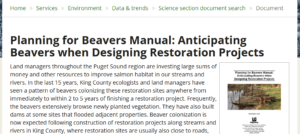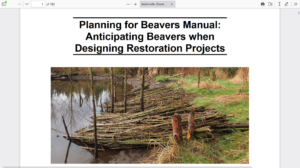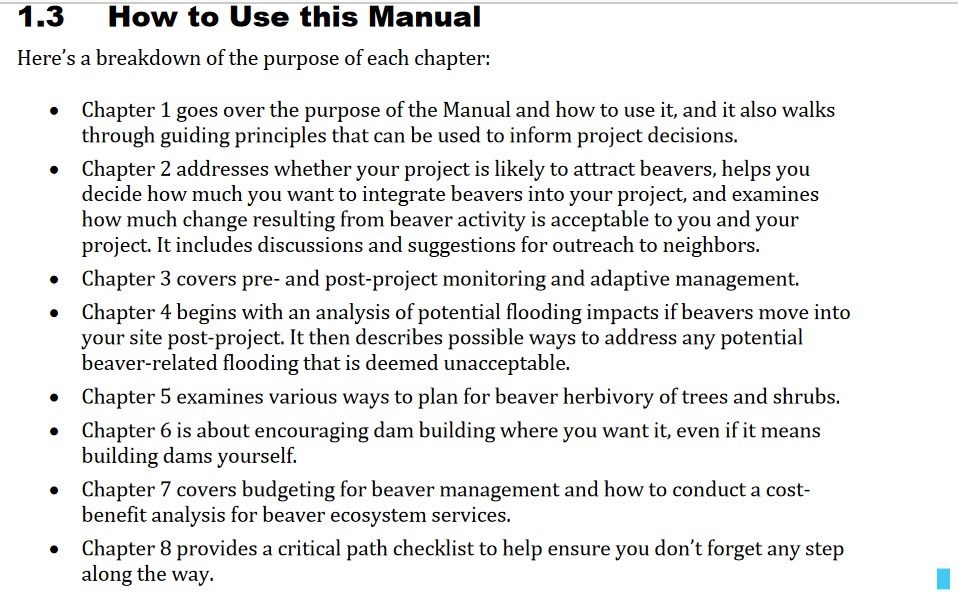Here’s the latest out of Washington States most beaver-believing county.
Tag: Jen Vanderhoof
A million years ago, back in 2007 when I was busily researching how to live with beavers to convince Martinez not to kill them there were on the entire internet thee sites about coexisting with beaver. I remember it like it was yesterday because I returned to them over and over. The first was Mike Callahan’s Beaver Solutions site which was full of information about flow devices and how they worked. The second was a single page on Beavers:Wetlands and Wildlife listing experts around the country that could help but who mostly didn’t exist or (in the case of California) weren’t experts, and the third was the beaver page from Kings County in Washington who had several pages on installing a beaver deceiver and why you would want to.
Well the world has changed DRAMATICALLY since then. But Kings County is still leading the way on all things beavers. Yesterday this report from them was released by our good friend Jen Vanderhoof,
Planning for Beavers Manual: Anticipating Beavers when Designing Restoration Projects
 Land managers throughout the Puget Sound region are investing large sums of money and other resources to improve salmon habitat in our streams and rivers. In the last 15 years, King County ecologists and land managers have seen a pattern of beavers colonizing these restoration sites anywhere from immediately to within 2 to 5 years of finishing a restoration project.
Land managers throughout the Puget Sound region are investing large sums of money and other resources to improve salmon habitat in our streams and rivers. In the last 15 years, King County ecologists and land managers have seen a pattern of beavers colonizing these restoration sites anywhere from immediately to within 2 to 5 years of finishing a restoration project.
Frequently, the beavers extensively browse newly planted vegetation. They have also built dams at some sites that flooded adjacent properties. Beaver colonization is now expected following construction of restoration projects along streams and rivers in King County, where restoration sites are usually also close to roads, culverts, farms, orchards, lawns, and houses. This Planning for Beavers Manual represents a proactive approach to restoration planning, as it assumes beavers will colonize restoration sites and incorporates the possible effects of their activity into each step of project planning and design.
Planning for beavers with the help of this Manual is intended to increase project success, help foster and maintain good relations with neighbors, reduce uncertainty associated with beaver activity, promote watershed ecology, and help project, program, and site managers better budget and plan for operations, maintenance, and monitoring.
Did you read that? Go back and read that if you didn’t. Kings County says yeah we have a lot of people wanting to restore the habitat for salmon but our beaver population is rebounding and it’s your job to EXPECT THEM and PLAN FOR THEM and they’ll make your little project better!
 Beavers provide many beneficial functions to ecosystems. In fact, they create ecosystems.
Beavers provide many beneficial functions to ecosystems. In fact, they create ecosystems.
Section 2.4 provides more information on the array of these benefits. Ideally, beavers could provide benefits without interfering with human infrastructure. But that isn’t realistic in many places. We therefore need new approaches to restoration project planning and implementation so we can maximize ecosystem and hydrologic benefits that beavers provide while minimizing impacts to infrastructure and vegetation in ways that it thrives alongside beaver herbivory.
If it’s not too much to ask, could I please be buried in Kings County? That is such an AWESOME smart opening pitch that I am beyond week in the knees. You want to do good things with your restoration project? So do beavers. Here’s how you let them.
Next the report walks through the principals used in ecological restoration and shows how beaver fit into ever single one. I particularly appreciated this:
Rarity Principle: Give primary consideration to rare, endemic ecosystems,
habitats, and species; species that exhibit wide population fluctuations; areas of high
native biodiversity; and key habitats and keystone species.
Beavers are a keystone species, which are to be given primary consideration under this principle. Even more precisely, they are ecosystem engineers. They create areas of high native biodiversity as they form wetland ecosystems and habitats that are used by more species than use non-beaver aquatic systems. Some rare and endangered species such as the Oregon spotted frog (Rana pretiosa) also use beaver wetlands.
We protect rare things. And beavers aren’t rare. But GUESS WHAT? Some of the wildlife that depends on them IS RARE. So we have to keep the beavers around to keep them around. Can I please sit Chuck Bonham down and read this aloud over and over?
After they list off all the ecological principles to consider they introduce a list of what they call “BEAVER PRINCIPALS”.
1. Beavers are ecosystem engineers.
Beavers are a highly skilled habitat engineers. They have been honing their skills at dam
building for somewhere between 3 and 10 million years. For context, modern salmon have
been swimming for about 6 million years, and Homo sapiens have only been walking
around for 300,000 years.
Consider beavers a partner in your project. Here are the roles they can be expected to play:
• Dam builder
• Mud mover
• Tree feller
• Water storer
• Canal and bank den excavator
• Sediment storer
These roles mean they can be relied on to aggrade sediment, increase channel complexity,
reconnect streams to floodplains, bring wood into streams, and increase base flow in
summer. These actions promote salmon recovery, ecosystem health, and resiliency in the
face of climate change. If you set up the project so beavers do some of the heavy lifting, they
become a partner instead of an antagonist.
That’s right. You have stepped right up and signed on to receive some whopping beaver benefits and here’s what you can expect them to do. Here’s what everybody BETTER expect them to do, if you take my meaning.
 No seriously THIS is an actual County Report, As in county employees were actually paid to write a research and type this. Because Washington is God’s country for beavers. It just is.
No seriously THIS is an actual County Report, As in county employees were actually paid to write a research and type this. Because Washington is God’s country for beavers. It just is.
The combination of wood and water at beaver ponds is a recipe for biodiversity. Water
levels rise and fall from beaver activity, and changing water levels kills some trees and
create snags. Beavers drop trees, which brings large wood into aquatic areas, and large
wood adds shade, creates pools, and provides protective cover for aquatic species. Beavers
excavate bank lodges in roots of trees, exposing more wood and shelter in water. They also
build dams and lodges, which are more sources of wood in water. These wood sources and
their functions provide ranges of water temperatures, water depths, flow rates, and organic
matter retention, the various combinations of which create unique niches for a variety of
plant and animal species. Table 1 provides examples of how the characteristics of beaver
wetlands affect different wildlife and other species.
3. Beaver systems need space.
Ecosystems need room to function properly, and along these same lines, beavers also need
space to provide their beneficial functions. There are two parts to this principle: space for wetland and aquatic features, and space for trees and shrubs.
A pond or open-water wetland takes more space than a stream channel, and multiple
stream channels take more space than a single channel. We know that healthy stream
systems are connected to their floodplains, and recent studies show connected systems
often have more than one channel. This means stream systems need more space than how
we have traditionally managed our stream corridors.
Beavers also need enough trees and shrubs to sustain them over time: too few stems for agood food supply and beavers will abandon the site. Beaver families naturally move in
response to food availability. Some will shift around within a relatively small geographic
area every few years, which gives the chewed vegetation a chance to regrow. But if they
arrive at a restoration project site, cut most everything that was available, and leave, the
dam will eventually fail, water storage and the water table will drop, biodiversity will
decline, and invasive species such as reed canarygrass will likely encroach on the newly
exposed shoreline. Not only do beaver ponds and affected streams need more room than
non-beaver areas, but the riparian and upland areas need to be large enough for
sustainable food supply
I simply cannot tell you the number of depredation permits I’ve reviewed from ecological preserves that were using grant money to restore habitat and needed to TRAP and kill some beavers because they were eating all the willow stakes they were trying to plant. Honestly. I swear it happens. From the Nature Conservancy to the Natomas Preserve they want to restore nature but kill it first. Because BEAVERS,
 Hey I have an idea about how to use this manual: READ IT. And make sure that any project that gets grant money from CDFW to restore habitat USES IT. You know I just got this notice yesterday:
Hey I have an idea about how to use this manual: READ IT. And make sure that any project that gets grant money from CDFW to restore habitat USES IT. You know I just got this notice yesterday:
CDFW Grants: CDFW Announces $200 Million in New Grant Funding Under Drought, Climate and Nature-Based Solutions
Wouldn’t it be a really really good idea if every project funded by these grants has to follow the guidelines laid out to anticipate and plan for beavers?
Yeah, I thought so too.
 The only beaver news today is that the stupid article from HCN ran on Wired and Verve so that everyone can have the chance to blame beavers for climate change. Nice. People often feel so helpless to stop it but just about anyone can kill a beaver, so that must offer hope to the situation.
The only beaver news today is that the stupid article from HCN ran on Wired and Verve so that everyone can have the chance to blame beavers for climate change. Nice. People often feel so helpless to stop it but just about anyone can kill a beaver, so that must offer hope to the situation.
Grr.
All is not lost though, because this excellent talk by Jen Vanderhoof, senior ecologist of Kings County and president of Beavers Northwest just appeared on and it’s a wondeful walk through beaver wonders with a true expert. If you have an extra ten minutes I would stay to hear the questions from the audience. It’s Washington and they are already SO SMART and ecologically savvy. I know you will enjoy this. She also says she is working on a beaver handbook which will come out this summer. Stay tuned!
[wonderplugin_video iframe=”https://youtu.be/UwLa4H2G6vQ” lightbox=0 lightboxsize=1 lightboxwidth=960 lightboxheight=540 autoopen=0 autoopendelay=0 autoclose=0 lightboxtitle=”” lightboxgroup=”” lightboxshownavigation=0 showimage=”” lightboxoptions=”” videowidth=600 videoheight=400 keepaspectratio=1 autoplay=0 loop=0 videocss=”position:relative;display:block;background-color:#000;overflow:hidden;max-width:100%;margin:0 auto;” playbutton=”https://www.martinezbeavers.org/wordpress/wp-content/plugins/wonderplugin-video-embed/engine/playvideo-64-64-0.png”]
Today Zane Eddy defends his masters thesis on the Martinez Beavers, and the academic world find out whether urban beavers matter. I of course will be tuning in like a ghost attending her own funeral. I just have to know how (if) it ends!
Meanwhile Washington is spending money on beavers again, and we should all follow suit.
King County’s culvert hunters — and a $9 billion plan to save salmon habitat
 It doesn’t look like much, this ditch by the side of the road. But to King County’s culvert hunters, this isn’t a throwaway landscape.
It doesn’t look like much, this ditch by the side of the road. But to King County’s culvert hunters, this isn’t a throwaway landscape.
Kat Krohn, an engineer and fish passage specialist for King County, chopped right into a fierce bramble of blackberries and got into the ditch as traffic roared by on a busy thoroughfare in Lake Forest Park. Here, Lyon Creek flows through Lake Forest Park before draining into the northwest corner of Lake Washington, crossing in culverts under roads and even private driveways all along the way.
That’s where Krohn and her teammates at King County come in. They are working in the field to compile an inventory of culverts on country roads, bridges and properties — the good, the bad, and the truly ugly in terms of whether a salmon can get through them to spawn or journey to the sea.
Urban creeks are the arteries and veins of the region carrying the lifeblood that animates the region’s ecology: salmon. Food for more than 123 species of animals — including endangered southern resident killer whales that frequent Puget Sound.
Imagine checking EVERY culvert in the county to see if fish can get by safely. Salmon are practically treated like royalty in Washington State. And guess what helps the royal family most?
A beaver dam attested to the help from nature’s primo wetland engineer, noted Jen Vanderhoof, a senior ecologist at King County working to support the coexistence of beavers in the watershed. Beavers can help boost biodiversity in a creek like this, Vanderhoof said, which is challenged by the effects of development, including both elevated temperature and pollutants.
The dams beavers build create pools that benefit baby salmon, and grow the insects and invertebrates that feed everything from fish to birds. Pools created by their beaver busyness also help recharge the hyporheic zone of the creek — where the water flows unseen, underground — maintaining flow and cooling temperature.
“Let the rodents do the work,” Vanderhoof said.
Not a wisecrack, but an insight, to not just treat symptoms, but instead restore natural processes that create healthier habitat and cleaner water in this creek. It is an important county stronghold for wildlife, home to not only coho, sockeye and Chinook, but freshwater mussels and sponges, river otters, crayfish and a teeming community of aquatic insects that stoke a web of life.
Who knew such things went on in urban streams and culverts! Wow you could almost write your master’s thesis on it!
I don’t know. Beavers might not be inspiring enough. What do you think? This photo of a beaver dam before the grand Tetons was sent by a friend of Rusty Cohn.







































